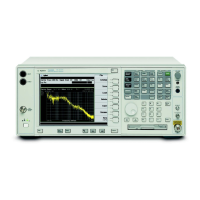426 Chapter 12
Post-Repair Procedures
Configuring a Replacement Flash Memory Assembly
Procedure
Step 1: Capture Configuration Information (if possible)
a. If the instrument is able to boot and display the softkey menus, it
should be possible to gather information using the following process.
If the existing Flash board will not allow this, the configuration
information will need to be obtained by other means described in the
“Non-Functional Instrument” section at the end of this procedure.
b. Power on the PSA.
c. Connect a printer to the PSA. If no printer is available, you will need
to carefully write down the options loaded, the license keywords for
each option and the IP Address and GPIB address.
d. On the PSA, press
System, More, Licensing, Show License to display
the list of loaded options and their associated option designators and
license key numbers. Press the
Print key on the PSA.
e. On the PSA, press
System, More, Show System. Under the Options
heading, you can see the designators for the hardware and firmware
options. Hardware options are 1DS (preamp), B7J (electronic
attenuator) and BAB (APC 3.5 connector). Press the
Print key on the
PSA to print the entire screen, or write down the option designators.
f. On the PSA, press
System, Config I/O. Press the Print button on the
PSA, or write down all information on the softkeys (the GPIB
address, the IP Address, Subnet Mask, and Default Gateway).
Step 2: Replacing the Flash Board
a. Power down the PSA.
b. Remove all cables attached to the rear panel of the PSA.
c. Refer to assembly replacement procedure “A26A1 DRAM and A26A2
Flash Boards” on page 388.
Step 3: Enter Option License Keyword Numbers (if needed)
Using the printout of loaded options and their associated option
designators and license key numbers, reinstall the options.
The option designation consists of three upper-case letters or numbers,
as shown in the table below.
Option Option Designation
Pre-amplifier 1DS
Phase Noise Measurement 226

